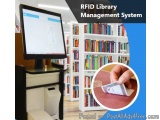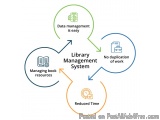Ad in: Gurgaon, India - Web Design & Tech
Library Management System - Price: Rs. 10



Ad # 869488
RFID library management system can be a detailed and informative piece. Here's an outline to guide you:
1. Introduction to RFID Library Management Systems:
- Define RFID (Radio Frequency Identification) and its application in library management.
- Explain how RFID systems work in libraries, including tags, readers, and software.
2. Key Components of an RFID Library Management System:
- RFID tags: Describe the tags used to label library materials, including their durability, encoding capabilities, and security features.
- RFID readers: Explain the devices used to read RFID tags, including fixed and handheld readers, and their role in inventory management and circulation.
- Library management software: Discuss the software used to manage RFID data, including cataloging, circulation, and patron management features.
3. Benefits of RFID Library Management Systems:
- Automation: Highlight how RFID systems automate tasks like inventory management, check-in/check-out, and shelf management, saving time and labor.
- Accuracy: Discuss how RFID systems improve accuracy in tracking library materials, reducing errors in circulation and inventory.
- Security: Explain how RFID systems enhance library security by providing real-time monitoring of materials and detecting unauthorized removal.
- User experience: Describe how RFID systems enhance the user experience by streamlining borrowing processes and providing self-service options.
- Space optimization: Discuss how RFID systems enable libraries to optimize space by facilitating efficient shelf management and collection organization.
4. Implementation Process:
- Planning: Discuss the initial steps involved in planning for the implementation of an RFID library management system, including needs assessment and budgeting.
- Installation: Explain the process of installing RFID hardware, including tags, readers, and antennas, and integrating them with existing library systems.
- Training: Highlight the importance of staff training in using RFID technology effectively and addressing any concerns or resistance to change.
- Testing and optimization: Describe the testing phase where RFID systems are evaluated for performance and fine-tuned to meet specific library needs.
5. Case Studies and Success Stories:
- Showcase examples of libraries that have successfully implemented RFID systems and the impact on their operations, such as improved efficiency, reduced costs, and enhanced user satisfaction.
- Include testimonials from librarians and patrons about their experiences with RFID technology.
6. Challenges and Considerations:
- Cost: Discuss the upfront investment required for RFID technology and the long-term cost savings it offers through improved efficiency and reduced labor.
- Privacy concerns: Address concerns about the use of RFID technology in libraries, such as data security and patron privacy, and how libraries can mitigate these concerns through policy and technology.
- Maintenance: Explain the ongoing maintenance requirements for RFID systems, including tag replacement, reader calibration, and software updates.
7. Future Trends and Innovations:
- Discuss emerging trends in RFID technology, such as hybrid RFID/barcode systems, cloud-based RFID solutions, and RFID-enabled smart libraries.
- Explore how RFID technology is evolving to meet the changing needs of libraries and users, such as integration with mobile devices and expansion into new applications like asset tracking and analytics.
8. Conclusion:
- Summarize the benefits of RFID library management systems in improving efficiency, accuracy, and user experience.
- Emphasize the importance of staying informed about RFID technology trends and innovations to ensure libraries remain competitive and meet the evolving needs of their communities.
For more details visit: https://www.libsys.co.in/ or write @ info@libsys.co.in or +911244894100
Your message has been sent
1. Introduction to RFID Library Management Systems:
- Define RFID (Radio Frequency Identification) and its application in library management.
- Explain how RFID systems work in libraries, including tags, readers, and software.
2. Key Components of an RFID Library Management System:
- RFID tags: Describe the tags used to label library materials, including their durability, encoding capabilities, and security features.
- RFID readers: Explain the devices used to read RFID tags, including fixed and handheld readers, and their role in inventory management and circulation.
- Library management software: Discuss the software used to manage RFID data, including cataloging, circulation, and patron management features.
3. Benefits of RFID Library Management Systems:
- Automation: Highlight how RFID systems automate tasks like inventory management, check-in/check-out, and shelf management, saving time and labor.
- Accuracy: Discuss how RFID systems improve accuracy in tracking library materials, reducing errors in circulation and inventory.
- Security: Explain how RFID systems enhance library security by providing real-time monitoring of materials and detecting unauthorized removal.
- User experience: Describe how RFID systems enhance the user experience by streamlining borrowing processes and providing self-service options.
- Space optimization: Discuss how RFID systems enable libraries to optimize space by facilitating efficient shelf management and collection organization.
4. Implementation Process:
- Planning: Discuss the initial steps involved in planning for the implementation of an RFID library management system, including needs assessment and budgeting.
- Installation: Explain the process of installing RFID hardware, including tags, readers, and antennas, and integrating them with existing library systems.
- Training: Highlight the importance of staff training in using RFID technology effectively and addressing any concerns or resistance to change.
- Testing and optimization: Describe the testing phase where RFID systems are evaluated for performance and fine-tuned to meet specific library needs.
5. Case Studies and Success Stories:
- Showcase examples of libraries that have successfully implemented RFID systems and the impact on their operations, such as improved efficiency, reduced costs, and enhanced user satisfaction.
- Include testimonials from librarians and patrons about their experiences with RFID technology.
6. Challenges and Considerations:
- Cost: Discuss the upfront investment required for RFID technology and the long-term cost savings it offers through improved efficiency and reduced labor.
- Privacy concerns: Address concerns about the use of RFID technology in libraries, such as data security and patron privacy, and how libraries can mitigate these concerns through policy and technology.
- Maintenance: Explain the ongoing maintenance requirements for RFID systems, including tag replacement, reader calibration, and software updates.
7. Future Trends and Innovations:
- Discuss emerging trends in RFID technology, such as hybrid RFID/barcode systems, cloud-based RFID solutions, and RFID-enabled smart libraries.
- Explore how RFID technology is evolving to meet the changing needs of libraries and users, such as integration with mobile devices and expansion into new applications like asset tracking and analytics.
8. Conclusion:
- Summarize the benefits of RFID library management systems in improving efficiency, accuracy, and user experience.
- Emphasize the importance of staying informed about RFID technology trends and innovations to ensure libraries remain competitive and meet the evolving needs of their communities.
For more details visit: https://www.libsys.co.in/ or write @ info@libsys.co.in or +911244894100
Other ads by this user:
The Role Of Erp Software In Modernizing Colleges, Institutes, And Universities Operations (Gurgaon, )
Items for Sale
)
Items for Sale
Educational Management Information System (emis) (Gurgaon, )
Computers & Electronics
)
Computers & Electronics
What Is Classroom Learning And Management Software? What Are The Advantages Of It? Why Educational Institutes Need It? (Gurgaon, )
Miscellaneous Items
)
Miscellaneous Items
Future Of Library Management System With Rfid In Educational Institutes (Gurgaon, )
Web Design & Tech
)
Web Design & Tech
Rfid Future And It’s Uses In Different Industries (Gurgaon, )
Miscellaneous Items
)
Miscellaneous Items
Latest Technologies And Advancement In Admission Portal For Educational Institutes (Gurgaon, )
Web Design & Tech
)
Web Design & Tech
Comprehensive Erp And Crm Solution For Student Lifecycle Management In Educational Institutes (Gurgaon, )
Web Design & Tech
)
Web Design & Tech
The Role Of Erp Software In Modernizing Colleges, Institutes, And Universities Operations (Gurgaon,
Educational Management Information System (emis) (Gurgaon,
What Is Classroom Learning And Management Software? What Are The Advantages Of It? Why Educational Institutes Need It? (Gurgaon,
Future Of Library Management System With Rfid In Educational Institutes (Gurgaon,
Rfid Future And It’s Uses In Different Industries (Gurgaon,
Latest Technologies And Advancement In Admission Portal For Educational Institutes (Gurgaon,
Comprehensive Erp And Crm Solution For Student Lifecycle Management In Educational Institutes (Gurgaon,